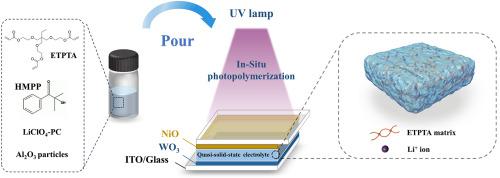Extraordinarily fast response all-solid-state electrochromic devices
IF 6.3
2区 材料科学
Q2 ENERGY & FUELS
引用次数: 0
Abstract
Gel polymer electrolytes have been acknowledged as a promising candidate within the realm of electrochromic devices (ECDs) for addressing the safety concerns of liquid electrolytes and overcoming the poor ionic conductivity inherent in solid electrolytes. Herein, a novel strategy for the simple fabrication of in-situ UV-curable gel polymer electrolytes has been proposed to enhance ionic conductivity and promote interface interactions, thereby facilitating remarkably fast response times. After rapid photopolymerization, the electrolyte containing 10 wt% trimethylolpropane ethoxylate triacrylate exhibits the highest ionic conductivity (1.42 mS cm−1), which is raised to a value of 1.79 mS cm−1 by the incorporation of alumina inorganic nanoparticles. Additionally, the polymer electrolyte demonstrates high optical transmittance, relatively notable interface adhesive strength (26 KPa), and outstanding thermal stability, with only a 5 % weight loss observed up to 126 °C. These distinctive characteristics enable the fabrication of all-solid-state WO3-NiO ECDs characterized by large optical modulation (50.82 %), super-short switching times (0.8 s for bleaching and 4.0 s for coloration), and exceptional cycling stability (95.7 % after 10,000 cycles, and 77.4 % after 15,000 cycles). This article effectively explores a straightforward method for fabricating high-performance all-solid-state ECDs, simplifying the process flow and enhancing the application prospects for ECDs.

超快响应全固态电致变色器件
凝胶聚合物电解质已被公认为是电致变色装置(ECD)领域中一种前景广阔的候选材料,它既能解决液态电解质的安全问题,又能克服固态电解质固有的离子传导性差的缺点。本文提出了一种简单制造原位紫外线固化凝胶聚合物电解质的新策略,以增强离子导电性和促进界面相互作用,从而缩短响应时间。经过快速光聚合后,含有 10 wt% 三羟甲基丙烷乙氧基化三丙烯酸酯的电解质显示出最高的离子电导率(1.42 mS cm-1),通过加入氧化铝无机纳米粒子,离子电导率提高到 1.79 mS cm-1。此外,这种聚合物电解质还具有很高的透光率、相对显著的界面粘合强度(26 千帕)和出色的热稳定性,在温度高达 126 °C 时仅有 5% 的重量损失。这些显著特点使得全固态 WO3-NiO ECD 的制造成为可能,这种 ECD 具有高光学调制率(50.82%)、超短切换时间(漂白 0.8 秒,着色 4.0 秒)和卓越的循环稳定性(10,000 次循环后 95.7%,15,000 次循环后 77.4%)。这篇文章有效地探索了制造高性能全固态 ECD 的简单方法,简化了工艺流程,提高了 ECD 的应用前景。
本文章由计算机程序翻译,如有差异,请以英文原文为准。
求助全文
约1分钟内获得全文
求助全文
来源期刊

Solar Energy Materials and Solar Cells
工程技术-材料科学:综合
CiteScore
12.60
自引率
11.60%
发文量
513
审稿时长
47 days
期刊介绍:
Solar Energy Materials & Solar Cells is intended as a vehicle for the dissemination of research results on materials science and technology related to photovoltaic, photothermal and photoelectrochemical solar energy conversion. Materials science is taken in the broadest possible sense and encompasses physics, chemistry, optics, materials fabrication and analysis for all types of materials.
文献相关原料
公司名称
产品信息
麦克林
PC (propylene carbonate)
麦克林
ETPTA
阿拉丁
HMPP
阿拉丁
LiClO4
 求助内容:
求助内容: 应助结果提醒方式:
应助结果提醒方式:


